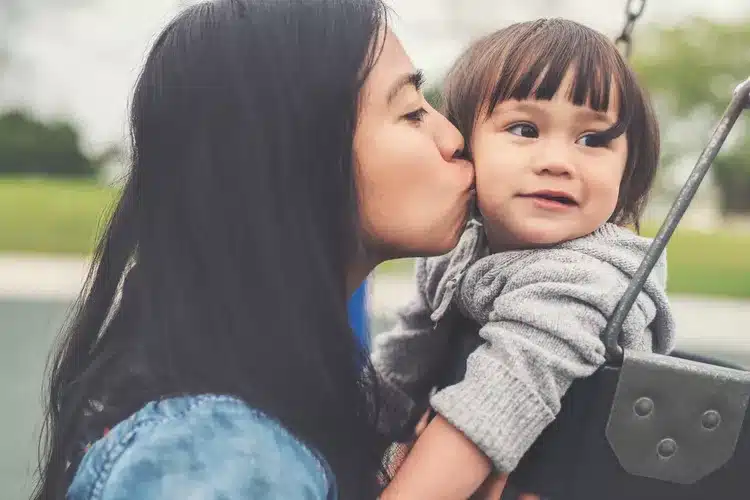Table of Contents
Have you ever wondered why some adults seem to have a magnetic connection with kids? You know the ones – the fun aunt who always has a group of kids following her around, or the kind neighbor who gets swarmed anytime he steps outside. What is it about these people that draws kids to them so naturally?
As it turns out, there are some clear qualities that make a person likable and approachable to children. Understanding what appeals to kids can help us build stronger bonds and create positive relationships with the children in our lives. Let’s explore what makes someone a kid magnet!
What Makes Someone Likable to Kids?
Kids have a natural ability to sense who they “click” with. While every child is different, research shows there are some common traits that make people intrinsically likable to kids.
Warmth and Friendliness
At our core, humans are social creatures. We’re instinctively drawn to people who radiate warmth. For children, who are new to navigating social relationships, a friendly, welcoming presence can feel especially magnetic.
Studies show that even infants prefer faces that appear happy and approachable. As kids get older, they gravitate towards adults who engage them with smiles and laughter. Simple acts like making eye contact, using a kid’s name, and initiating conversation signal that you’re interested in connecting.
Playfulness and Humor
What’s the fastest way to get a group of kids to swarm around you? Crack a few jokes or be willing to get silly! Kids love laughter, so having a playful, humorous nature naturally attracts them.
Making funny voices and faces, telling jokes (even cheesy ones), or doing something ridiculous like dancing with abandon can quickly win over kids. Playfulness shows them you’re willing to be authentic and let loose.
In fact, studies show that children learn more effectively when humor is incorporated into teaching. So by being playful, you’re also making it easier for them to listen and engage.
Patience and Adaptability
Kids live very much in the moment, moving from one thought or activity to the next rapidly. For adults, this can be exhausting to try to keep up with! Having patience and learning to adapt to a child’s pace and interests are key to connecting.
Rather than redirecting kids if they get sidetracked or antsy, patient adults roll with the punches. They’re flexible about changing activities and conversational topics and don’t get flustered by interruptions. This accepting approach makes kids feel heard and valued.
Enthusiasm and Positive Energy
Think of the adults you loved being around as a kid. Chances are, they shared your excitement about the little things and made you feel great just by being around them.
Kids feed off of positive energy. When you’re enthusiastic about listening to their stories or playing games they enjoy, it’s contagious. Your excitement reaffirms that they and their interests are worthy of your attention.
Positivity also puts kids at ease, as they instinctively mimic the emotional states of adults. Smiling and speaking in an upbeat, affirming tone signals to kids that you’re someone safe and trustworthy.
Building Strong Connections
Simply having the above traits, however, isn’t always enough to build close relationships with kids. You also need the skills to translate those qualities into meaningful interactions.
Developing Rapport Through Play
Play comes naturally to kids, so meeting them on their level is a great way to cultivate rapport. Get involved in what engages them – whether it’s rolling toy cars, having a tea party, or making up silly dances.
Don’t be afraid to be fully present and let your inner child come out! Studies confirm that adults build stronger connections with kids through play because it creates a shared fun experience.
Practicing Active Listening
In the busyness of life, we often listen to respond rather than truly hear what someone is saying. With kids, practicing active listening is key to making them feel valued.
Give them your undivided attention when they’re speaking. Maintain eye contact, limit distractions, and ask engaged questions. Paraphrase back what you heard and allow time for pauses. You’ll be surprised what kids will open up about when they feel heard!
Using Non-Verbal Communication
Kids rely heavily on non-verbal cues, so being expressive through your body language, facial expressions, and tone of voice is impactful. For example, leaning in while a child is talking signals you’re fully engaged.
Equally important is “reading” the non-verbal messages kids are putting out based on their posture, gestures, and demeanor. Tune into these unspoken forms of communication to better respond to their needs.
Showing Empathy and Emotional Intelligence
Kids experience big emotions. When you empathize with their feelings and respond compassionately, it brings you closer together.
Imagine how you would want someone to react if you were anxious, angry, or overjoyed, then provide that same listening ear and emotional validation to kids. With time, they learn they can trust you with their innermost thoughts and feelings.
Respecting Kids as Individuals
It’s easy to unintentionally put kids into boxes, based on stereotypes about age, gender, and behavior. But taking time to see and appreciate each child’s uniqueness is instrumental for connection.
Avoiding Stereotypes and Biases
Don’t assume that an outgoing boy is not also sensitive, or that a strong-willed girl can’t also have moments of insecurity. Instead, make room for all dimensions of a child’s personality to come through.
Be aware of and check any unconscious biases you may have about kids who are “difficult,” “shy,” or “weird.” Work on seeing the value in every child.
Recognizing Unique Personalities and Interests
Just like adults, every kid has their own peculiarities. Make it a game to discover what makes each one tick. Does Sam love Grossology facts? Is Robin a budding artist? Getting to know kids’ quirks helps them feel truly seen.
Kids light up when you remember the random details that reflect their singular passions. Asking engaged questions and tolerating long conversations about niche interests pays off in deeper relationships.
Adapting Communication Style
Kids have different needs and responses when it comes to communication. For some, quiet listening is best. Others thrive on verbal affirmation. Many need help processing emotions through talk or play.
Pay attention to how each child interacts and tailor your approach accordingly. Are they visual, auditory, or kinesthetic learners? Do they need time to warm up or dive right into socializing? Meeting them where they are is key.
Understanding Child Development
Children go through remarkable changes in social, emotional, cognitive and physical development from birth through adolescence. Understanding where kids are at developmentally allows you to connect more meaningfully.
Different Developmental Stages
Babies need sensory stimulation, toddlers seek independence through play, school-agers require reasoning explanations, and teens crave discussions about identity.
Learning about milestones like object permanence, growth of language, development of empathy, etc. provides insight into appropriate communication strategies.
Social and Emotional Changes
As kids mature, their social and emotional skills expand dramatically. They move from separation anxiety to parallel play to cooperative play and complex peer interactions.
Understanding healthy emotional development equips you to help kids cultivate skills like self-regulation, confidence, and relating well to others.
Adapting Expectations
Children can only thrive when expectations align with their developmental capabilities. School-agers can follow multi-step directions but expecting independent reading from a preschooler sets them up for frustration.
Kids will rise to meet appropriately high expectations that encourage growth. But development can’t be rushed, so be flexible in adapting objectives to their maturity level.
Creating a Supportive Environment
For kids to fully trust and open up to adults, they need environments where they feel secure – both physically and emotionally.
Providing Physical and Emotional Safety
Ensure kids’ basic needs are met and they are free from harm or neglect. Make time spent together positive and relaxed, not belittling, tense, or chaotic. Healthy relationships require safe foundations at home.
Give reassurance during difficult emotions and remind kids you are there for them. Having your consistent support builds resilience when life gets hard.
Encouraging Independence and Self-Expression
Allow opportunities for kids to make age-appropriate choices so they can practice self-reliance and responsibility. Let them take the lead in play and conversations, asking lots of open-ended questions.
Children learn who they are by trying on different identities and interests. Give them space for this exploration without judgement so they can develop self-confidence.
Setting Clear Boundaries and Expectations
While some flexibility is good, kids ultimately thrive on routines and understanding what’s expected of them. Gently enforce boundaries while giving them the reasoning behind rules.
When kids know what to anticipate in their environments, it provides comfort and helps them integrate positive behaviors. Consistency prepares them for future success.
Understanding why kids gravitate towards some adults more than others reveals valuable insights about children’s social needs. By cultivating warmth, playfulness, empathy and other kid-friendly traits, you become someone children inherently delight being around.
Making the effort to actively listen, communicate on their level, appreciate their individuality, and nurture their development forges bonds that can last a lifetime. Who knew making connections with kids could be so fulfilling?
The next time you see a “kid magnet” effortlessly engaging with little ones, realize it’s never by accident. With care and intention, we can all become the type of adult who makes children feel safe, seen, and valued – and reap the rewards of those special relationships!
Frequently Asked Questions:
What are some specific ways I can get better at relating to kids?
Some great techniques include:
- Get on their level physically by bending down to their eye level when you interact. This makes them feel heard and respected.
- Ask open-ended questions about their interests and encourage them to tell stories. Kids love to share about their lives when prompted.
- Incorporate activities you know they already enjoy into your time together, like certain games, books, or creative outlets. It shows you “get” them.
- Validate their feelings when they’re upset rather than minimizing them. Say something like “I see this made you feel really sad, and that’s okay.”
Why do some kids take longer to warm up to new people?
It’s completely normal and developmentally appropriate for some kids to need more time before feeling comfortable. Factors like innate shyness, new social situations, and even you as a novel stimulus can lead to initial reluctance. Don’t take it personally. Just meet the child where they are, allow them to observe first, and let connection happen gradually. Moving too fast can be counterproductive.
What are signs a child feels safe and connected with me?
Indicators include smiling, laughing, and generally seeming relaxed in your presence. When kids share openly about their lives, interests, and feelings, it shows trust. They may also display affection through hugs, hand-holding, sitting close to you, or “helping” with tasks. Seeking you out regularly to play or chat are also great relationship signs!
Is it okay to use bribes or treats to get kids to like me?
While this may work in the short-term, rewarding kids with candy or gifts can actually undermine real relationships. Children may learn to spend time with you only for concrete rewards, not for authentic connection. Instead, cultivate liking through non-material ways like playfulness, active listening, and shared interests. The bonds that form will be much richer.
What are the most crucial elements for relating well to kids?
The keys are: 1) Meeting them developmentally where they are at and adjusting expectations accordingly. 2) Practicing empathy by seeing their perspective. 3) Respecting their individuality and avoiding comparisons. 4) Active listening without distractions. 5) Cultivating trust and safety in the relationship. Mastering these will set you up for meaningful interactions.

